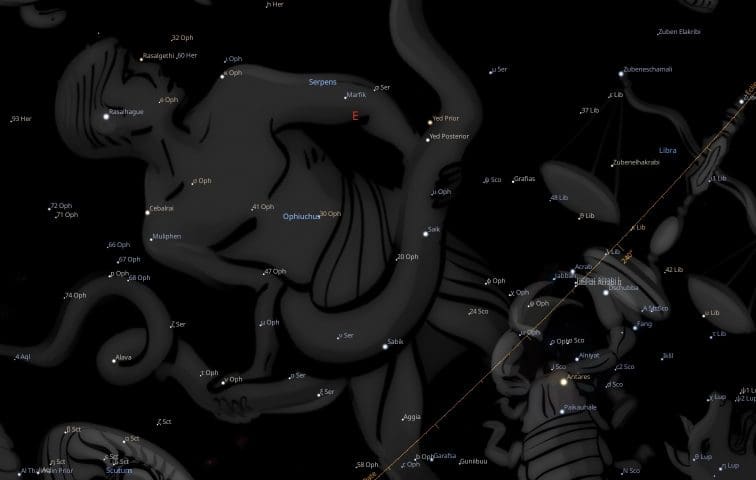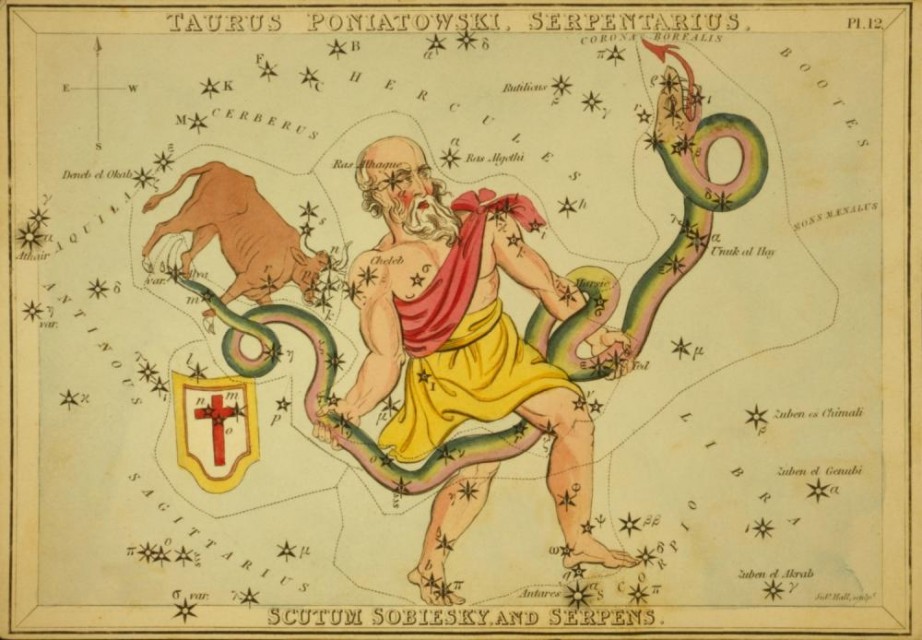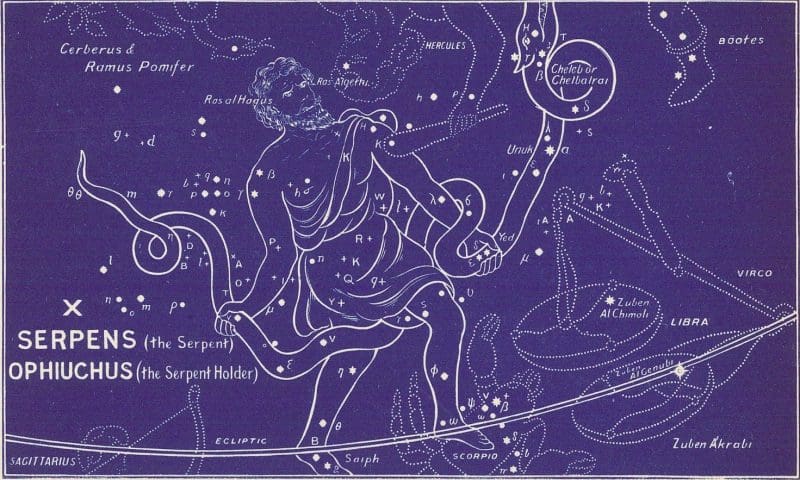FIXED STARS: Major Stars | 1000+ Stars | Constellations | About
Constellation Ophiuchus, the Serpent Holder, is a northern constellation bordering Libra, Scorpius, Sagittarius, Serpens, Aquila, Hercules and the obsolete constellations Cerberus and Taurus Poniatovii.Ophiuchus is one of the 48 constellations listed by Ptolemy in the 2nd century and remains one of the 88 modern constellations. It spans over 30 degrees of the zodiac in the Signs of Sagittarius and Capricornus.
Abbreviation: Oph
Genitive: Ophiuchi
Ophiuchus Constellation Stars
| 2000 | 2050 | Star | Name | Sp. Class | Mag. | Orb |
|---|---|---|---|---|---|---|
| 02♐18 | 03♐00 | δ Oph | Yed Prior | M1 | 2.73 | 2°00′ |
| 03♐30 | 04♐13 | ε Oph | Yed Posterior | G8 | 3.23 | 1°40′ |
| 05♐35 | 06♐18 | λ Oph | Marfik | A2 | 3.82 | 1°30′ |
| 06♐33 | 07♐15 | υ Oph | She Low | A3 | 4.62 | 1°00′ |
| 07♐33 | 08♐15 | ψ Oph | K0 | 4.48 | 1°10′ | |
| 07♐58 | 08♐41 | χ Oph | B2 | 4.22 | 1°20′ | |
| 08♐40 | 09♐22 | φ Oph | G8 | 4.29 | 1°20′ | |
| 09♐14 | 09♐56 | ζ Oph | Han (Saik) | O9 | 2.54 | 2°00′ |
| 11♐49 | 12♐31 | κ Oph | Helkath | K2 | 3.19 | 1°40′ |
| 12♐24 | 13♐06 | 20 Oph | F7 | 4.64 | 1°00′ | |
| 17♐58 | 18♐40 | η Oph | Sabik | A2 | 2.43 | 2°10′ |
| 20♐00 | 20♐42 | 36 Oph | Guniibuu | K1 | 4.33 | 1°10′ |
| 20♐35 | 21♐17 | σ Oph | K3 | 4.34 | 1°10′ | |
| 20♐54 | 21♐36 | ξ Oph | Aggia | F2 | 4.39 | 1°10′ |
| 21♐23 | 22♐06 | θ Oph | Garafsa | B2 | 3.27 | 1°40′ |
| 22♐27 | 23♐09 | α Oph | Rasalhague | A5 | 2.08 | 2°10′ |
| 22♐53 | 23♐35 | 45 Oph | Kang | F3 | 4.28 | 1°20′ |
| 25♐20 | 26♐02 | β Oph | Cebalrai | K2 | 2.76 | 2°00′ |
| 26♐40 | 27♐20 | γ Oph | Bake-eo | A0 | 3.75 | 1°30′ |
| 29♐45 | 00♑27 | ν Oph | Sinistra | K0 | 3.32 | 1°40′ |
| 00♑10 | 00♑43 | 67 Oph | B5 | 3.93 | 1°30′ | |
| 00♑29 | 01♑11 | 68 Oph | A2 | 4.42 | 1°10′ | |
| 01♑31 | 02♑13 | 70 Oph | K0 | 4.03 | 1°20′ | |
| 02♑09 | 02♑51 | 72 Oph | Phorbaceus | A4 | 3.71 | 1°30′ |
β Oph is officially named Cebalrai. Applied in recent times from its indigenous Arabic name kalb al-rā‘ī, “the Shepherd’s Dog” (in other traditions, α Her and 28/29 Cep are given the same name). The dog, together with the shepherd (marked by α Opi), and the two lines of stars enclosing the Pasture (see β CrB), and all the dim stellar sheep in that portion of the sky (al-ghanam or al-aghnäm for the sheep), seem to form a complete group of indigenous Arabic figures. [1]
β Oph is named Zōngzhèngyī (宗正一), “1st Star of Official for Royal Clan” in Chinese astronomy. It is also known as Nèipíng (内平), meaning “High judge”. [2]
γ Oph is officially named Bake-eo, a Marshallese name which refers to the spondylus mussel. [3]
γ Oph also has the traditional name Muliphen, derived from the Arabic muhlifān, meaning “two [things] causing dispute.” [1] However, Muliphein is the official name for γ CMa, and Muhlifain is the traditional name for γ Cen.
γ Oph is sometimes also known as Al Durajah, which is the name of a famous Arab charioteer. [4]
ε Oph is officially named Yed Posterior. Originally from the Arabic word al-yad, “the hand,” used in the Arabic Almagest in these stars [and δ Oph, Yed Prior]. yed was applied as a star name to δ Oph in medieval times. Then, in recent times, this application was extended to include both δ and ε, with the addition of the Latin distinctions for “foremost” and “hindmost,” respectively. [1]
ε Oph was the Euphratean Nitaχ‑bat, “the Man of Death.” Coincidentally, “in modern astrology, which contains some singular survivals, the Hand of Ophiuchus is said to be a star of evil influence.’ ” [5]
ε Oph is known as Chǔ (楚), “Star of Chu” in Chinese astronomy. [2] It represents an ancient Chinese state during the Zhou dynasty.
θ Oph has the Arabic names Imad, meaning “pillar,” and Al Hawwa, which means “standing place.” They refer to the “moral and spiritual pillar” in ancient Arabic. [4]
θ Oph also has the traditional name Kaki, which means “foot.” [4]
θ Oph has also been called Garafsa, Persian for “snake charmer.” However, θ Oph was part of the asterism Garafsa with η Oph, ζ Oph, and ξ Oph. [4]
θ Oph with ξ Oph was the Sogdian Wajrik, “the Magician”; the Khorasmian Markhashik, “the Serpent-bitten”; and the Coptic Tshiō, “the Snake”, and Aggia, “the Magician”; η Oph being included in the last two. [5]
κ Oph is known as Helkath, a Hebrew-Arabic name meaning ”battlefield.” [4] Helkath (חֶלְקַת) is a location on the boundary of the tribe of Asher.
λ Oph is officially named Marfik. Applied since medieval times from the Arabic word al-marfiq, “the elbow,” used in the Arabic Almagest in describing this star. While the medieval transliteration was marsic (with a confusion of f and the long-shaped s), Marfik is an improved spelling of recent times. [1]
ξ Oph is sometimes named Aggia, a Coptic word meaning “Magician.” [4]
ξ Oph with θ Oph was the Sogdian Wajrik, “the Magician”; the Khorasmian Markhashik, “the Serpent-bitten”; and the Coptic Tshiō, “the Snake”, and Aggia, “the Magician”; η Oph being included in the last two. [5]
υ Oph was She Low, “a Market Tower” according to Allen. [5] Its actual Chinese name is Chēsìyī (車肆一), “1st star of Commodity Market.” [2]
36 Oph is officially named Guniibuu, meaning “robin red-breast bird” (Petroica boodang), from the Kamilaroi and Euahlayi Aboriginal peoples in New South Wales, Australia. [6]
45 Oph is known as Kāng (糠), “Chaff” in Chinese astronomy. [2]
72 Oph is named Phorbaceus, referring to a hero named Phorbas, who saved the island of Rhodes from an attack of snakes. [4]
Ophiuchus Astrology
Manilus
When Ophiuchus, encircled by the serpent’s great coils, rises he renders the forms of snakes innocuous to those born under him. They will receive snakes into the folds of their flowing robes, and will exchange kisses with these poisonous monsters and suffer no harm.
One called Ophiuchus holds apart the serpent which with its mighty spirals and twisted body encircles his own, that so he may untie its knots and back that winds in loops. But, bending its supple neck, the serpent looks back and returns; and the other’s hands slide over the loosened coils. The struggle will last forever, since they wage it on level terms with equal powers. [7]
Robson
Legend. This constellation is said to represent the infant Hercules who strangled two serpents sent by Juno to kill him as he lay asleep in his cradle (see SERPENS).
Influence. According to Ptolemy, it is like Saturn and moderately like Venus. It is said to give a passionate, blindly good-hearted, wasteful and easily seduced nature, unseen dangers, enmity and slander. Pliny said that it occasioned much mortality by poisoning. This constellation has also been called Aesculapius and held to rule medicines. By the Kabalists it is associated with the Hebrew letter Oin and the 16th Tarot Trump “The Lightning Struck Tower”.
Magical. Drives away poisons and cures venomous bites. [8]
Noonan
Serpentarius is now called Ophiuchus (Oph) and was noted in classical times as the constellation of those who had the power of discovering healing herbs and skill in curing the bites of poisonous serpents. According to Greek tradition, the constellation is Asclepois or Aesculapius, who was a lineal ancestor of the great physician Hippocrates. Ptolemy says that its stars have the nature of Saturn and, to some degree, Venus. Pliny said that these stars were dangerous to mankind, occasioning much mortality by poisoning. But in regard, it must be noted that the constellation of Serpentarius has been the home of a large number of comets throughout history. It would be the comets, of course, that would account for the effects noted by Pliny. In a genearthical chart the constellation denoted prudence and wisdom. [9]
Allen
Ophiuchus vel Serpentarius, the Serpent-Holder stretches from just east of the head of Hercules to Scorpius; partly in the Milky Way, divided nearly equally by the celestial equator; but, although always shown with the Serpent (Serpens), the catalogs have its stars entirely distinct from the latter. The original title, Ophioukhos, appeared in the earliest Greek astronomy; mogeros, “toiling,” being an adjectival appellation in the Phainomena.
Cicero and Manilius had the peculiar Anguitenens. Golius insisted that this sky figure represents a Serpent-charmer, one of the Psylli of Libya, noted for their skill in curing the bites of poisonous serpents; and this would seem to be confirmed by the constellation’s title le Psylle in Schjellerup’s edition of Al Sufi’s work.
But the Serpent-holder generally was identified with Asklepios, Asclepios, or Aesculapius, whom King James I described as “a mediciner after made a god,” with whose worship serpents were always associated as symbols of prudence, renovation, wisdom, and the power of discovering healing herbs. Educated by his father Apollo, or by the Centaur Chiron, Aesculapius was the earliest of his profession and the ship’s surgeon of the Argo. When the famous voyage was over, he became so skilled in practice that he even restored the dead to life, among these being Hippolytus, of whom King James wrote: Hippolyte. After his members were drawn in sunder by four horses, Esculapius, at Neptune’s request, glued them together and revived him.
But several such successful operations and numerous remarkable cures, and especially the attempt to revive the dead Orion, led Pluto, who feared for the continuance of his kingdom, to induce Jove to strike Aesculapius with a thunderbolt and put him among the constellations. Euphratean astronomers knew it, or a part of it with Serpens, as Nu-tsir-da; and Brown associates it with Sa-gi-mu, the God of Invocation.
Pliny said that these stars were dangerous to mankind, occasioning much mortality by poisoning; while Milton compared Satan to the burning comet that “fires” this constellation, — a comparison perhaps suggested by the fact that noticeable comets appeared here in the years 1495, 1523, 1537, and 1569, which might well have been known to Milton, for Lord Bacon wrote in his Astronomy: Comets have more than once appeared in our time; first in Cassiopeia, and again in Ophiuchus… according to his idea of the boundaries, this actually is more of a zodiacal constellation than is the Scorpion. But the boundaries are very variously given by uranographers. [5]
Bullinger
Here, Serpens, the serpent, is seen struggling vainly in the powerful grasp of the man who is named O-phi-u-chus. In Latin he is called Serpentarius. He is at one and the same moment shown to be seizing the serpent with his two hands, and treading on the very heart of the scorpion, marked by the deep red star Antares (wounding).
Just as we read the first constellation of the woman and child Coma, as expounding the first sign VIRGO, so we have to read this first constellation as expounding the second sign LIBRA. Hence, we have here a further picture, showing the object of this conflict on the part of the scorpion. In Scorpio we see merely the effort to wound Ophiuchus in the heel; but here we see the effort of the serpent to seize THE CROWN, which is situated immediately over the serpent’s head, and to which he is looking up and reaching forth.
There are no less than 134 stars in these two constellations. Two are of the 2nd magnitude, fourteen of the 3rd, thirteen of the 4th, etc. The brightest star in Ophiuchus, α (in the head), is called Ras al Hagus (Arabic), the head of him who holds. [10]
References
- A Dictionary of Modern Star Names, Kunitzch, Smart, 2006, p.22, 44-45.
- Ophiuchus in Chinese Astronomy.
- SkeEye: (Uncommon Star Names).
- List of stars in the constellation Ophiuchus – Wikipedia.
- Star Names: Their Lore and Meaning, Richard H. Allen, 1889, p.302-303.
- 36 Ophiuchi – Wikipedia.
- Astronomica, Manilius, 1st century AD, book 1, p.31, book 1, p.31, book 5, p.333
- Fixed Stars and Constellations in Astrology, Vivian E. Robson, 1923, p.54, 231.
- Fixed Stars and Judicial Astrology, George Noonan, 1990, p.22.
- The Witness of the Stars, E. W. Bullinger, 1893, Ophiuchus (the Serpent Holder).


